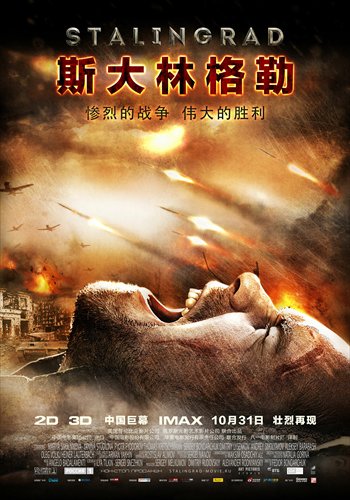‘Stalingrad’ revisited

The weighty drama Stalingrad arrives in Chinese theaters today after a strong showing in Russian cinemas. Photo: Courtesy of Sony Pictures Entertainment
Russian director Fyodor Bondarchuk's latest World War II epic, Stalingrad, which opens in Chinese mainland theaters today, is a work to remind the newer generations about the lessons of the past.
Stalingrad, with an international cast of Russian and German actors, such as Pyotr Fyodorov (The Darkest Hour) and Thomas Kretschmann (The Pianist), stood out in Russia with a heaviness not usually seen in wide-release motion pictures. It has been selected as Russia's entry for best foreign language film in next year's Academy Awards.
The film has already earned $22 million in Russia and former Soviet countries in its opening week, making it the ninth highest grossing Russian film, according to The Hollywood Reporter.
Determined not to forget
As the title implies, the film recounts the Battle of Stalingrad, which took place from the summer of 1942 to February 2, 1943, and stands as one of the bloodiest battles in history.
In a group interview with Chinese media, director Bondarchuk said he chose to shoot a film on the Battle of Stalingrad because of its significance in Russian history as a major turning point in World War II - when it started to turn in Russia's favor.
Though the history of this battle is included in Russian textbooks, Bondarchuk finds it is being forgotten. In an informal survey carried out before filming began, the production team found that about 30 percent of Russians had forgotten about the battle.
"So I hope those who have forgotten this history can experience what happened at that time, at that place in the cinema," Bondarchuk added.
Stalingrad is built not on big, brutal scenes featuring legendary figures, but on unknown soldiers and fights that may not even have a name.
Suffering a setback attempting to cross the Volga, several scattered Soviet soldiers manage to land on shore, where the whole city is under German control. Hiding in a destroyed house, they meet a local girl, Katya. Living with Katya, the soldiers feel a certain affection for the girl and share their stories in their last days keeping the Germans from occupying the house.
Bondarchuk told the media that there have been a number of war films over the decades, and he does not think a repetition of these battle scenes is needed.
"We all know the result brought by a war - you may lose your family, and lose the place you once lived," he said. "I want to bring [such thoughts] to audiences that a war between two countries is not simply victory to one side or defeat to the other. More often the civilians suffer."
In creating five soldiers of different ages, personalities and backgrounds, Bondarchuk believes audiences will be better able to sympathize as they can identify with at least one character.
Patriotic notions are not the focus for Stalingrad's soldiers. The war they fight in is more about survival. "I don't want to talk big, saying how deep my love is for my country," he said. "I think it is the biggest act of patriotism when everyone fights for the person he loves and for the family."
'Real truth' of film
The film doesn't only depict the Soviet side of the conflict. Bondarchuk weaves in a tragic love story between a German Nazi officer and a Soviet woman. Without sharing a language between them, the two fall in love, but their story is destined to be a wartime tragedy.
Bondarchuk told the Chinese media Monday evening that though some Russian audiences are unhappy with the setting of this story, he believes it speaks to a real truth.
Having met with veterans who actually experienced the Battle of Stalingrad, the director learned that not all German soldiers were as dim and inhumane as they are portrayed in other war films.
"[They] told me some German soldiers were in a good relationship with the local people, bringing them food and drink," Bondarchuk said, adding that such romance did exist between German soldiers and local women.
Born to direct
One of the best known filmmakers in Russia, the Moscow-based director, actor and producer was born into a film family - his father Sergei Bondarchuk was an Academy Award-winning director, while his mother Irina Skobtseva was an actress. But Fyodor Bondarchuk, now 49, seldom considered working in the film industry until he went to the Russian State Institute of Cinematography. He said his father did not have many demands on his future and he enrolled in the army for two years before studying film.
Best known for his 2006 film The 9th Company, about the Soviet war in Afghanistan, Bondarchuk said he had not thought about producing another war film since then. Yet, he thinks it a wise choice to take on this topic.
The Battle of Stalingrad has been portrayed many times by different countries - US director Sidney Salkow's The Boy from Stalingrad (1943), Stalingrad (1989) directed by Yuri Ozerov from the former Soviet Union and Stalingrad (1993) by German director Joseph Vilsmaier, but Bondarchuk wants to make his work different both in content and technology.
"It is the first time 3D technology is used in shooting a film in Russia, and Hollywood technicians were invited to join," said the director.
The director believes with the help of 3D, audiences can better experience the feeling of being surrounded in a burning city that Soviet soldiers lived through in November 1942.
He also links the Battle of Stalingrad with the tsunami that happened in Japan, and said he did this because he wants audiences to link the past to the present.
It is a filmmaker's life pursuit to get rid of the boundary between film and audience as much as possible, he said.